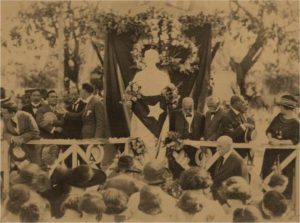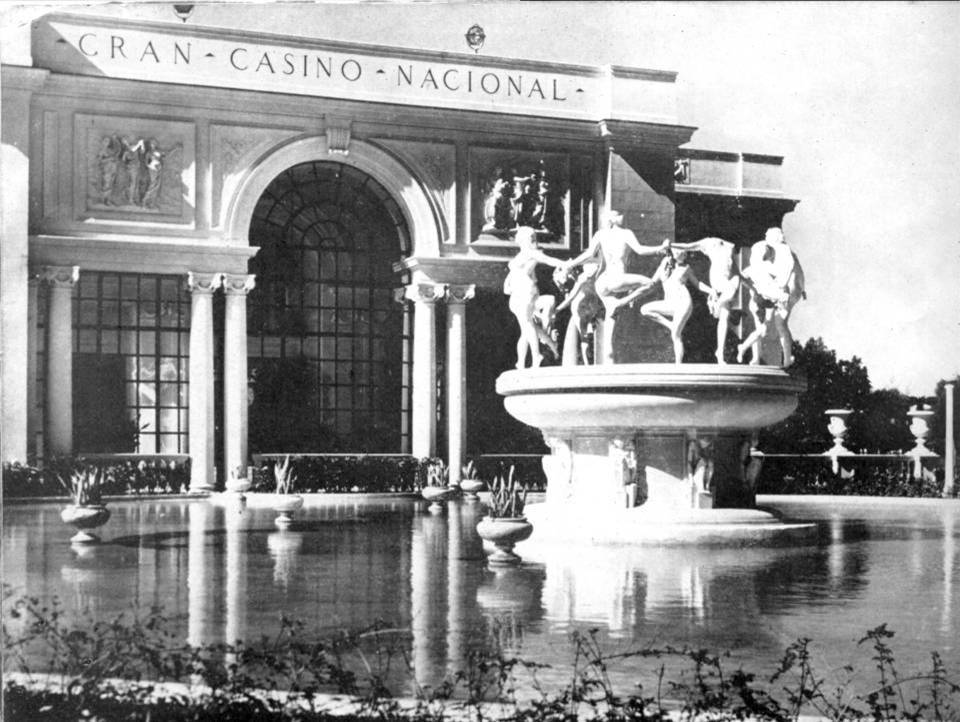During the three early decades of the 1900s Italian sculptors «will make zafra» in Cuba.
There is an emblematic sculpture of Havana night in Havana. Is is of it called source of the Muses, located in the entrance of the cabaret Tropicana. Its name is the dance of the hours, and is a monumental work in which eight fully nude dancers dance with grace and delicacy, on the edge of a fountain. Was located in the exterior of the Casino national, in the corner of the streets 11 and 120, in the old cast Country Club, today Cubanacan. The national Casino disappeared in the 1940s. In 1953, Martín Fox, owner of Tropicana, acquired the dance of the hours. You paid for it ten thousand pesos and since then, with the name of fountain of the Muses, serves as a symbol to the famous cabaret in the Havana suburb of Marianao. Its author is Mario Gamba, Italian sculptor.
Indeed, as extra comment of the Italian presence in Cuba, such the prawn was a character in the night of Havana and his Bohemian life and above all his gallant adventures gave rise to quite a few comments. That fine and friendly man lost day brackets and undertook her shot against Esther Vera, the young woman of British origin based in Havana that had relations. It is unknown if it is the girl rejected his proposal of marriage or if she wanted to break the romance to learn that her boyfriend was married in Italy… Gamba had to respond to justice for their acts. Even private of freedom, made some orders, since to that stage corresponds the mentioned source of the muses. Would their models for these muses why…?
Italy and its makers in Cuba.
The Republic opens, in 1902, a stage of institutionalization of the historical memory… Is in that effort of cutting nationalist is erected also monuments to no few figures of the independence.
Carlo Nicoli is the author of the statue of Miguel de Cervantes in the Park of San Juan de Dios. Domenico Boni it is of it’s Antonio Maceo in the park that carries his name. A monument that no longer exists, the President Alfredo Zayas, which was erected in the space that it occupies the Granma Memorial, was work of the Italian Vanetti, and Emilia de Córdova, in the Viper, Ettore Salvatori. The statue of the Republic, an of them sculptures more high that there are low ceiling in the world, is work of Angelo Zanelli, author also of other important works that is exhibit in the Palace of the laws.
The name of Giovanni Nicolini is repeated at least three times. Fruit of its talent are them monuments to Tomás Estrada Palma, in G and fifth, in the Vedado, and in whose pedestal are only the shoes of the President; the greater espirituano General Alejandro Rodríguez, at the intersection of line and walk, and the lavish Memorial to major general José Miguel Gómez, second President of Cuba, in the G Street between 27 and 29, also in the Vedado.
Aldo Gamba leaves also in Cuba three works, because in addition to the called the dance of the hours, joins the equestrian statue of major general Ignacio Agramonte, in Camagüey and planned and executed the monument to the major general Max Gomez, at the beginning of the mission Avenue, at the entrance of the Bay. It’s an equestrian statue in bronze, on a wide pedestal for marble and granite. The Warrior appears in costume of campaign, uncovered and look high.
This is only part of a past of the art Italian and their creators in Cuba. The past was always better. (AV)
Agencies / MemoriasCubanas / Derubín Jácome / Internet Photos / Arnoldo Varona / TheCubanHistory.com
THE CUBAN HISTORY, HOLLYWOOD.
ESCULTORES ITALIANOS DEJAN SUS HUELLAS CLÁSICAS EN CUBA.
Durante las tres décadas iniciales de los 1900s los escultores italianos «harán zafra» en Cuba.
Hay en La Habana una escultura emblemática de la noche habanera. Se trata de la llamada Fuente de las Musas, emplazada en la entrada del cabaret Tropicana. Su nombre es La Danza de las Horas, y es una obra monumental en la que ocho bailarinas, completamente desnudas, danzan, con gracia y delicadeza, sobre el borde de una fuente. Estuvo situada en el exterior del Casino Nacional, en la esquina de las calles 11 y 120, en el antiguo reparto Country Club, hoy Cubanacán. El Casino Nacional desapareció en los años 40. En 1953, Martín Fox, propietario de Tropicana, adquirió La Danza de las Horas. Pagó por ella diez mil pesos y desde entonces, con el nombre de Fuente de las Musas, sirve de símbolo al afamado cabaret de la barriada habanera de Marianao. Su autor es Mario Gamba, escultor italiano.
Por cierto, como comentario extra de la presencia italiana en Cuba, el tal Gamba era un personaje de la noche de La Habana y su vida bohemia y sobre todo sus aventuras galantes dieron pie a no pocos comentarios. Ese hombre fino y amable perdió un día los estribos y la emprendió a tiros contra Esther Vera, la joven de origen británico radicada en La Habana con la que llevaba relaciones. Se desconoce si es que la muchacha rechazó su propuesta de matrimonio o si ella quiso romper el romance al enterarse de que su novio era casado en Italia… Gamba tuvo que responder ante la justicia por sus actos. Aun privado de libertad, realizó algunos encargos, ya que a esa etapa corresponde la mencionada Fuente de las Musas. ¿Serían sus modelos para estas Musas el motivo…?
Italia y sus creadores en Cuba.
La República se abre, en 1902, una etapa de institucionalización de la memoria histórica.. Es en ese empeño de corte nacionalista se erigen también monumentos a no pocas figuras de la independencia.
Carlo Nicoli es el autor de la estatua de Miguel de Cervantes en el parque de San Juan de Dios. Domenico Boni lo es de la de Antonio Maceo en el parque que lleva su nombre. Un monumento que ya no existe, el del presidente Alfredo Zayas, que se erigió en el espacio que ocupa el Memorial Granma, fué obra del italiano Vanetti, y el de Emilia de Córdova, en La Víbora, de Ettore Salvatori. La Estatua de la República, una de las esculturas más altas que existen bajo techo en el mundo, es obra de Angelo Zanelli, autor asimismo de otras importantes obras que se exhiben en el Palacio de las Leyes.
El nombre de Giovanni Nicolini se repite por lo menos tres veces. Fruto de su talento son los monumentos a Tomás Estrada Palma, en G y Quinta, en el Vedado, y en cuyo pedestal quedan solo los zapatos del mandatario; el del mayor general espirituano Alejandro Rodríguez, en la intersección de Línea y Paseo, y el fastuoso monumento al mayor general José Miguel Gómez, segundo presidente de Cuba, en la calle G entre 27 y 29, también en el Vedado.
Aldo Gamba deja asimismo en Cuba tres obras suyas, pues además de la llamada La Danza de las Horas, se suma la estatua ecuestre del mayor general Ignacio Agramonte, en Camagüey y proyectó y ejecutó el monumento al mayor general Máximo Gómez, al comienzo de la Avenida de las Misiones, a la entrada de la bahía. Se trata de una estatua ecuestre en bronce, sobre un amplio pedestal de mármol y granito. El guerrero aparece en traje de campaña, con la cabeza descubierta y la mirada en alto.
Esta es solo parte de un pasado del arte Italiano y sus creadores en Cuba. Siempre el pasado fue mejor. (AV)
Agencies/MemoriasCubanas/Derubín Jácome/Internet Photos/Arnoldo Varona/ TheCubanHistory.com
THE CUBAN HISTORY, HOLLYWOOD.










